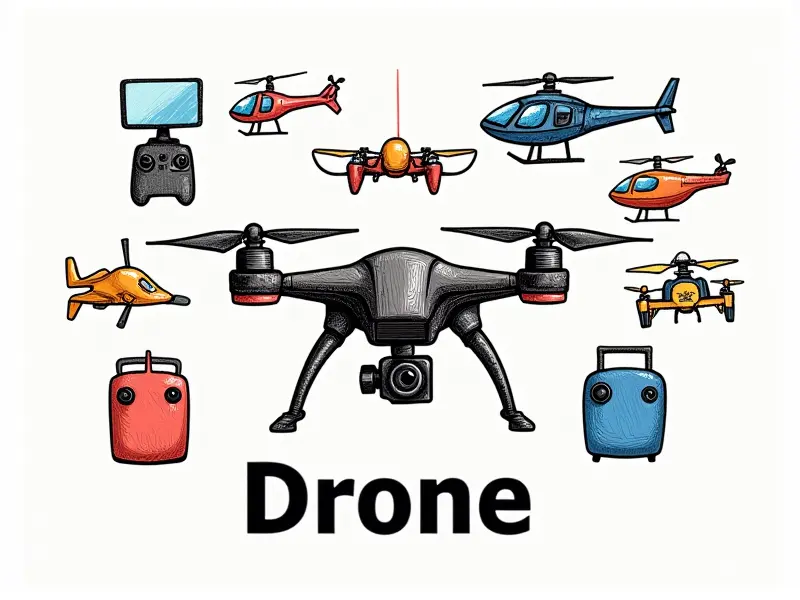What's a radio transmitter for?

Why Your Drone Needs a Good Transmitter
A high-quality radio transmitter is essential for drone pilots to ensure smooth and safe operation. A good transmitter provides reliable signal strength, extended range, and precise control over your drone’s movements. This ensures that you can capture stunning aerial footage without worrying about losing connection or experiencing lag.
Understanding Radio Transmitters in RC
In the realm of remote-controlled (RC) devices such as drones, cars, boats, and planes, radio transmitters play a crucial role. They transmit signals to the receiver installed on the device, enabling real-time control over its movements. Understanding how these transmitters work is fundamental for any hobbyist or professional looking to optimize their RC experience.
Mastering RC Transmitter Controls for Beginners
For beginners in the world of RC technology, mastering transmitter controls can be daunting but essential. Familiarize yourself with basic functions such as throttle, pitch, roll, and yaw control. Practice flying or driving your RC device in an open space to get comfortable with these commands before attempting more complex maneuvers.
Key Controls Explained
- Throttle: Controls the speed of the motor or propeller.
- Pitch: Adjusts the angle of ascent and descent.
- Roll: Manages left and right movement.
- Yaw: Regulates turning direction.
Top Features in Modern RC Transmitters
Modern radio transmitters come packed with advanced features designed to enhance user experience. Some of the top features include:
Built-in GPS and Compass
These features help maintain orientation and provide accurate positioning data, crucial for navigating your device in unfamiliar areas.
Versatile Connectivity Options
- Bluetooth: For pairing with smartphones or tablets for telemetry data.
- WiFi: Enables remote updates and firmware upgrades.
Customizable Profiles
Allows users to save different settings for various RC devices, making it easy to switch between them without losing configurations.
Choosing the Right RC Transmitter for You
Selecting an appropriate transmitter depends on your specific needs and preferences. Consider factors like range requirements, desired features, budget constraints, and intended use (e.g., racing, aerial photography).
Key Factors to Consider
- Range: Ensure the transmitter offers sufficient coverage for your activities.
- Battery Life: Look for models with long-lasting batteries to avoid interruptions during use.
- User Interface: Opt for a user-friendly interface that simplifies control and setup processes.
The Basics of RC Transmitter Functionality
Radio transmitters operate on specific frequencies, sending signals to the receiver through radio waves. These signals are then decoded by the receiver to execute commands sent from the transmitter. Understanding this basic principle is vital for troubleshooting and optimizing performance.
Frequency Bands Explained
- 2.4GHz: Commonly used due to its wide range and low interference.
- 72MHz: Ideal for high-performance applications requiring precise control.
Essential Tips for RC Transmitter Setup
Proper setup is crucial for optimal performance. Follow these tips to ensure your transmitter works seamlessly with your RC device:
Calibrate the Receiver
Ensure both transmitter and receiver are properly calibrated before use.
Check Signal Strength
Verify that signal strength is adequate, especially in crowded areas or long-range scenarios.
RC Transmitter Range and Performance
The range of your radio transmitter significantly impacts its effectiveness. Factors like environmental conditions, obstacles, and frequency interference can affect performance. Understanding these variables helps you maximize the potential of your RC setup.
Increasing Range Tips
- Use Antennas: Extendable or external antennas improve signal transmission.
- Avoid Interference: Stay clear of other electronic devices operating on similar frequencies.
How to Use RC Transmitters Effectively
To use your radio transmitter effectively, practice regularly and experiment with different settings. Familiarize yourself with advanced features like telemetry data for enhanced control over your device’s performance.
Practice Makes Perfect
- Start Slow: Begin with basic maneuvers before attempting complex ones.
- Monitor Data: Use telemetry to track important metrics like battery levels and speed.
Maximizing Performance with RC Transmitters
To get the most out of your radio transmitter, keep it well-maintained and updated. Regularly check for firmware updates and perform routine maintenance tasks such as cleaning contacts and replacing batteries.
Maintenance Tips
- Clean Contacts: Ensure all connections are free from dirt and corrosion.
- Update Firmware: Stay current with the latest software improvements.
Why Every Pilot Needs a Good Transmitter
A reliable radio transmitter is indispensable for any pilot, whether amateur or professional. It ensures smooth operation, enhances safety, and allows you to fully enjoy your RC experience without technical frustrations.
Conclusion
In summary, investing in a high-quality radio transmitter is crucial for optimal performance of your remote-controlled devices. By understanding its functionality, mastering controls, and maintaining it properly, you can unlock the full potential of your RC setup and enjoy unparalleled control over your devices.

